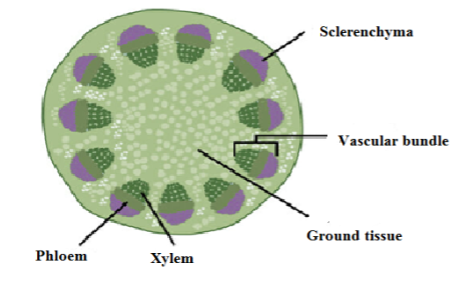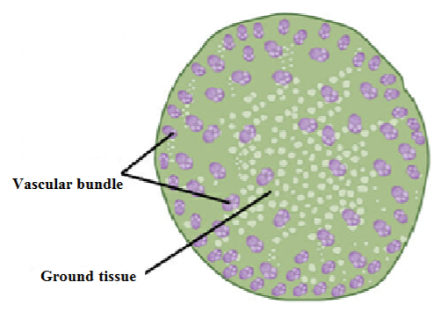
Describe the vascular tissue system with the help of diagrams.
Answer
495k+ views
Hint: Vascular tissue is a complex system of conducting tissues found in plants. All the different types of vascular tissue within a particular plant constitute the vascular tissue system of the plant.
Complete answer:
To solve this question, we have to understand the tissue system of plants. We know that the plants prepare their own food in the leaf by using the water, minerals from the soil and the roots of plants need nutrients to grow and provide support to the plants. So, there must be some kind of connection which helps the passage of water, minerals and nutrients within the different parts of the plants.
Vascular tissues are groups of tissues that transport or conduct the passage of fluid and nutrients. They are arranged in such a way that the passage of transporting materials can be transported easily. The cells in vascular tissues are typically long and slender. Vascular tissue is made up of more than one cell type, found in most of the vascular plants.
The vascular tissue system consists primarily of two types of cells which are xylem and phloem. Both the cells are responsible for the conduction of water, minerals and nutrients throughout the plant. Xylem cells help to transport water and nutrients from roots to stem and are long cells, consisting of two other types of cells known as parenchyma and fibres. Phloem is responsible for transporting sugars and other organic molecules.
Vascular tissues are arranged in the form of long distinct strands which are known as vascular bundles. In addition to the xylem and phloem, the vascular bundles also include other supporting and protecting cells. In between the xylem and phloem, there exists a meristem which is known as vascular cambium.

Vascular Bundles

Vascular tissue system in dicot stem

Vascular bundle in monocot stem
Note: The Vascular system acts as the primary conducting system of plants and helps in movement and transportation of water, minerals and nutrients to different parts of the plant. It includes xylem and phloem.
Complete answer:
To solve this question, we have to understand the tissue system of plants. We know that the plants prepare their own food in the leaf by using the water, minerals from the soil and the roots of plants need nutrients to grow and provide support to the plants. So, there must be some kind of connection which helps the passage of water, minerals and nutrients within the different parts of the plants.
Vascular tissues are groups of tissues that transport or conduct the passage of fluid and nutrients. They are arranged in such a way that the passage of transporting materials can be transported easily. The cells in vascular tissues are typically long and slender. Vascular tissue is made up of more than one cell type, found in most of the vascular plants.
The vascular tissue system consists primarily of two types of cells which are xylem and phloem. Both the cells are responsible for the conduction of water, minerals and nutrients throughout the plant. Xylem cells help to transport water and nutrients from roots to stem and are long cells, consisting of two other types of cells known as parenchyma and fibres. Phloem is responsible for transporting sugars and other organic molecules.
Vascular tissues are arranged in the form of long distinct strands which are known as vascular bundles. In addition to the xylem and phloem, the vascular bundles also include other supporting and protecting cells. In between the xylem and phloem, there exists a meristem which is known as vascular cambium.

Vascular Bundles

Vascular tissue system in dicot stem

Vascular bundle in monocot stem
Note: The Vascular system acts as the primary conducting system of plants and helps in movement and transportation of water, minerals and nutrients to different parts of the plant. It includes xylem and phloem.
Recently Updated Pages
The correct geometry and hybridization for XeF4 are class 11 chemistry CBSE

Water softening by Clarks process uses ACalcium bicarbonate class 11 chemistry CBSE

With reference to graphite and diamond which of the class 11 chemistry CBSE

A certain household has consumed 250 units of energy class 11 physics CBSE

The lightest metal known is A beryllium B lithium C class 11 chemistry CBSE

What is the formula mass of the iodine molecule class 11 chemistry CBSE

Trending doubts
State the laws of reflection of light

One Metric ton is equal to kg A 10000 B 1000 C 100 class 11 physics CBSE

Difference Between Prokaryotic Cells and Eukaryotic Cells

How do I convert ms to kmh Give an example class 11 physics CBSE

Describe the effects of the Second World War class 11 social science CBSE

Which of the following methods is suitable for preventing class 11 chemistry CBSE




